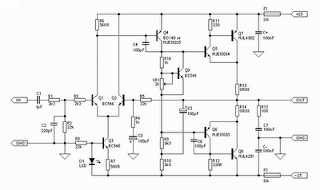The water-tank level meter de-scribed here is very simple and useful for monitoring the water level in an overhead tank (OHT). The water level at 30cm intervals is monitored and continuously indicated by LEDs ar-ranged in a meter-format. When all the LEDs are ‘off’, it indicates that the OHT is empty. When the water level reaches the top limit, the whole LED-meter begins to flash. The height at which the level-sensing electrodes are fitted is adjustable. Thus, the minimum and maximum level settings may be varied as desired. The range of the meter can also be enlarged to cater to any level. No special or critical components are used. CMOS ICs are used to limit the idle current to a minimum level.
Even when all the LEDs are ‘on’, i.e. water reaches the top level, the demand on the power supply is reasonably low. Further, the extremely high input resistance of the Schmitt inverter gates reduces the input current and thus minimises the erosion of electrodes. The princi-pal part of the device is its water-level sensor assembly. By using easily available material, it can be fabricated to meet one’s own specific requirements. The common ground reference electrode ‘X’ is an aluminium conduit of 15mm outer diameter and 3-metre length, to cater to a 3-metre deep overhead tank. Insulating spacer rings ‘Y’ (10mm length, 15mm dia.) are fabricated from electrical wiring conduits of 15mm inner diameter.
These are pushed tightly over the aluminum conduit at preferred places, say 30cm apart. If the pieces are too tight, they can be heated in boiling water for softening and then pushed over ‘X’. The sensor electrodes ‘Z’ are made out of copper or brass strips (6mm wide and 1mm thick) which are shaped into rings that can tightly slip over the ‘Y’ pieces. The ends of these strips are folded firmly and formed into solder tags S1 to S10 and SG. The wall-mounting brackets, made of aluminium die-cast, are screwed directly on ‘X’ at two suitable places.

The sensor cable ‘WC’ wires are soldered to solder tags, and some epoxy cement is applied around the joints and tags to avoid corrosion by water. The common ground reference wire ‘SG’ is taken from tag ‘T’. The cable’s individual wires from S1 to S10 and SG are cut and matched in length for a neat layout. The other ends of the cable are connected to the PCB terminal points S1 to S10 and SG respectively. No separate ground is needed. The electronics portion is simple and straightforward. A long piece of vero board can hold all the parts including the power supply section.
For easy installation, the LEDs can be set at the track side of the board, in a single line, so that they may be pushed through the cutouts in the front panel of the enclosure from inside. The water level at 30cm intervals is monitored by corresponding sensors, causing the input to the concerned inverters (normally pulled ‘high’ via resistors R1 through R10) to go ‘low’, as soon as water reaches the respective sensors On initial switching ‘on’ of the power supply, when the tank is empty, all the electrodes are open. As a result, all the inverter inputs are ‘high’ (via the pull-up resistors R1 to R10) and their outputs are all ‘low’. Thus, all the LEDs are ‘off ’. As soon as the water starts filling the tank, the rising water level grounds the first sensor.
The logic 1 output of first inverter gate N1 causes conduction of transistor T2 to extend ground to one side of resistors R14 through R23 via emitter collector path of transistor T2. The LED D1 is thus lit up. Similarly, other LEDs turn ‘on’ successively as the water level rises. As soon as the water in OHT reaches the top level, the output of gate N10 goes to logic 1 and causes flashing-type LED D11 to start flashing. At the same time, transistor T1 conducts and cuts off alternately, in synchronism with LED D11’s flash rate, to ground the base of transistor T2 during conduction of transistor T1. As a result, transistor T2 also starts cutting ‘off’ during conduction of transistor T1, to make the LED meter (comprising LEDs D1 through D10) flash and thus warn that the water has reached the top level.
When the water level goes down, the reverse happens and each LED is turned ‘off’ successively. The novel feature of this circuit is that whenever the water level is below the first sensor, all the LEDs are ‘off’ and the quiescent current is very low. Thus, a power ‘on’/‘off’ switch is not so essential. Even when the LED-meter is fully on, the cur-rent drawn from the power supply is not more than 120 mA. A heat-sink may, how-ever, be used for transistor T2, if the tank is expected to remain full most of the time. A power supply unit providing unregulated 6V DC to 15V DC at 300mA current is adequate.
Caution. A point to be noted is that water tends to stick to the narrow space at the sensor-spacer junction and can cause a false reading on the LED-meter. This can be avoided if the spacers are made wider than 10 mm.
Author : M.K. Chandra MouleeswAran - Copyright : EFY
























